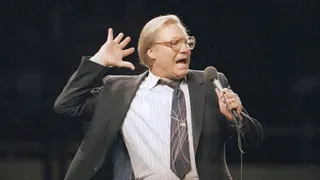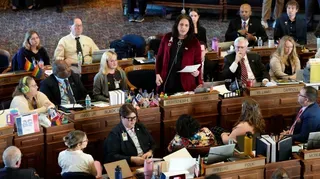November 30, 2013
Bent-Con Celebrates Gay Geekdom
David Perry READ TIME: 7 MIN.
Freaks, geeks, and the gays who love them descended upon Burbank, Calif., on Nov. 8 - 10 for the fourth annual Bent-Con comic book convention. Celebrating LGBTQ icons in the industry, both real and animated, the event is one part expo, one part networking extravaganza and the one time the LGBTQ community can as a whole joyously expose the world to its full-frontal nerdity.
While far more modest than the mammoth San Diego ComicCon, the Bent-Con, in the four years of its existence, has gone from a small event held at a bar, to commandeering the exhibition space at the Burbank Marriott and Convention Center for 48 solid hours and drawing up to 4,000 visitors.
"It's a lot like ComicCon, only gayer," says Hollywood producer and Bent-Con vice president Jody Wheeler. "A lot of brave people, when it wasn't time, when it wasn't appropriate, said, 'Now we're going to put some gay characters in here.' We celebrate that, and everybody across the board who is interested, excited, and does this kind of stuff or is fans of this kind of work."
What A Long, Strange Trip It’s Been
As literature, illustration (which includes print and animation) is/was the last to be taken seriously, giving artists more leeway to approach subjects that censor-wary movie directors and authors historically avoided. LGBTQ issues, however, is a story of incremental gains.
Cartoons first appeared in 1908, comic books in 1933, and sexuality, albeit aimed at a heterosexual audience, was present almost from the start. Clad in a form-fitting, backless-strapless flapper number, Betty Boop has been giving audiences an eyeful since 1930, a look Red Hot Riding Hood ran with in blazing Technicolor in 1943. The two characters set the standard for physically hyper-idealized and scantily/sexily clad illustrated women in comics and animation today, from Wonder Woman (introduced in 1942) to Storm (1975) to Jessica Rabbit, whose va-va-va-voom proportions have held onlookers in a visual headlock since 1988's "Who Framed Roger Rabbit." Only since the 90s have men been so idealized, with impossibly wide shoulders, thick arms, 0 percent body fat, and muscles in permanent flexure.
While depictions of homosexuality go back to ancient Sumer the Comics Code Authority (CCA), formed partially in reaction to the fear Batman and Robin (introduced in 1939) were lovers, forbade any comic book from broaching homosexual subjects -- a ban that stayed in place until 1989. Undaunted, artists turned to underground publications and pornography for outlets; unmistakably gay characters appeared in 1968 with the explicit sexual adventures of "Captain Pissgums" and "His Pervert Pirates" in Zap Comix. Kake, the iconic character created by Tom of Finland, also conforms to a comic-book character. By the 1980s, gay characters took on major roles in daily serials outside the CCA's authority like "Doonesbury" and "For Better or For Worse," and major publishers Marvel and DC had gays and lesbians in one-off and minor roles in defiance of the ban, though mostly as villains or victims. The "Sandman" series, begun in 1989 and largely credited for reinvigorating the entire comic book genre, was quixotic: Many lesbian characters were elevated to heroic status, while gay men were victimized, murderous, amoral, or otherwise antagonistic.
It was the 1992 outing of Marvel's Northstar that is considered the seminal step forward for heroically-portrayed LGBTQ characters in comics. Originally intended to be openly gay when introduced in 1979 and nearly killed off by homophobic editors before an in-house revolt at Marvel saved him, Northstar most recently made history when he married his partner in 2012. Archie Comics, long considered the industry bastion of innocence, drew massive praise in 2010 with introduction of Kevin Keller, and wasted no time in setting the bar with regard to an undiluted depiction of a realistic gay man. Kevin proved so popular the issue sold out, forcing Archie Comics to issue a reprint, a first. Today, all major publishers, and several fantasy/sci-fi TV shows, have gay characters, both heroic and villainous. Writer and lesbian Leia Weathington won "Best Writer Award" at the Stumptown Comics Fest last year in Portland, beating out powerhouse Greg Rucka (who, coincidently, writes for Batwoman, a lesbian heroine in the Batman mythos) for "The Legend of Bold Riley," a fantasy featuring a lesbian protagonist.
Still a Need?
Despite this growing acceptance of LGBTQ characters in mainstream comics, gay artists insist the Bent-Con is a necessary event, and gay comics a necessary category. Wheeler maintains that for all the gains gays and lesbians have made in the industry, the comics/sci-fi/fantasy community is still largely seen as heterosexual. ComicCon is so huge that smaller sub-genres get shoved to the side; Wheeler sees the Bent-Con pulling triple duty as an LGBTQ spotlight, safe-zone, and forum.
"One area people still don't think about gay people being in are the big comics, making Sci-Fi films, creating video games, and doing art about fantastic worlds," says Wheeler. "Bent-Con shows off a slightly different element of our community, and a really popular one. We have all kinds of people who are in these kinds of imaginative areas and subjects. Visitors have said, 'I thought I was the only one' which is kind of funny - it's the kind of thing you used to think about being gay."
"You can go to any convention and you'll definitely find your gays there," says exhibitor Dave Davenport. Creator of the "Feral & Ghost Skater" serial and one of the original organizers of Bent-Con, Davenport tells EDGE that while no "con" nor con-goers are particularly hostile towards gay artists, work expounding gay themes regarding sex and romance strikes a nerve.
"You get a good deal of people who will not look in your direction or turn bright red as they walk by," he says, admitting that about 35 percent of Bent-Con illustration is erotic in nature, going on to explain that the Bent-Con originally was an homoerotic art fair designed to create an outlet for artists.
"The majority of LGBT comics and graphic novels are conspicuously devoid of anything sexual, and this is strategy that I think, although well intentioned, is bad for our community in the long run," says writer-artist Jon Macy, whose groundbreaking "Teleny & Camille," based on a nearly forgotten homoerotic romance attributed to Oscar Wilde, is largely regarded as putting gay comics on the map and won the 2010 Lambda Literary Award for best gay erotica.
"Many creators willingly sanitize their work to maximize their readership," Macy continues, "but I say that keeping consenting and loving characters from even kissing sends the message 'queers are ok as long as I don't have to see them doing things that make ME uncomfortable.' Shows like "True Blood" prove there is a market for work of a mature same-sex nature. Comics are no longer only for children, it is perfectly suited to adult themes whether they are overt or not."
There are blurred lines, to be sure. Gay character Naked Justice, who goes into battle nude and shoots lightning bolts from his erection, is clearly meant to titillate, but he is only slightly more explicit than Rose Tattoo, a mainstream character who subdues her enemies by having sex with them, and Wolverine, who often loses his clothes before a fight. Unlike the American mainstream, LGBTQ comics as a rule do not shy away from depictions of sex or nudity when it is pertinent to the storyline. Bent-Con artists uniformly agree that sex has to be depicted in LGBTQ comics for the category to stay relevant.
"There are expressions of tenderness and love and connection that come off as false unless they include the nudity, passion, and intensity that you get from depicting sex openly and honestly," observes Zan Christensen, owner of LGBTQ comics publisher Northwest Press. "Not every project is going to call for explicit sex, but I think that any book with love and sex and relationships will benefit from a more healthy, unashamed view of sexuality."
The Art of the Con
Bent-Con functions like any other con, with vendors setting up stalls to display their work and mingle with fans, panels, game rooms open around the clock, and a cornucopia of queer cosplay. Every aspect of the LGBTQ experience, if through a fantastical lens, is explored, from the adventures of "Glamazonia, the Uncanny Super Tranny," by Justin Hall, to "Fearful Hunter," a meta-masculine Druid-Werewolf romance by Macy.
Despite being the baby on the con circuit and still largely an indie artist event, Bent-Con already attracts mainstream attention. Novelist Christopher Rice and actress Claudia Christian, who attained cosmic diva status through her work on "Babylon 5" and "Halo," where joined on panel discussions by prolific writer Jane Espenson, who crafted several scripts for "Buffy the Vampire Slayer," "Once Upon a Time," and the gay-themed web series "Husbands." Wendy Pini, mastermind of the cult comic "Elfquest," and openly gay artist Phil Jimenez of "Wonder Woman" fame were also on hand.
"It's one of those places where, if you know the names of all the doctors, it's totally appreciated," Wheeler says proudly (referencing "Doctor Who"). "It may not go over well in other gay circles, but here, you will find people who appreciate your knowledge of all of Wolverine's costumes and the history of what geekery you like. It's pretty fantastic."
David Perry is a freelance travel and news journalist. In addition to EDGE, his work has appeared on ChinaTopix, Thrillist, and in Next Magazine and Steele Luxury Travel among others. Follow him on Twitter at @GhastEald.




